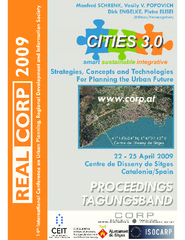Prikaz osnovnih podataka o dokumentu
The New Urban Acupuncture: Intermodal Nodes between Theory and Practice
| dc.contributor | Schrenk, Manfred | |
| dc.contributor | Popovich, Vasily V. | |
| dc.contributor | Engelke, Dirk | |
| dc.contributor | Elisei, Pietro | |
| dc.creator | Stupar, Aleksandra | |
| dc.creator | Savcic, Vladimir | |
| dc.date.accessioned | 2020-04-05T12:18:52Z | |
| dc.date.available | 2020-04-05T12:18:52Z | |
| dc.date.issued | 2009 | |
| dc.identifier.isbn | 978-39502139-6-6 | |
| dc.identifier.isbn | 978-39502139-7-3 | |
| dc.identifier.uri | https://raf.arh.bg.ac.rs/handle/123456789/563 | |
| dc.description.abstract | The intermodal nodes, as important interchange areas of contemporary cities, represent one of the most vibrant and challenging elements of the current urban transformations. Frequently considered as initiators or generators of further urban and regional connectivity, accessibility and development, they are excellent experimental polygons for new planning strategies. Thus, the intermodal areas, originally perceived as marginal zones and used as the basic transportation support, upgrade their mono-functional background introducing the globally recognizable set of activities. The main idea of this process is to create an improved urban system, based upon latest technologies and proclaimed imperatives of urban efficiency, competitiveness and sustainability. Therefore, the purpose of this paper is to present and analyze context, content and implications of intermodality and the transformations caused by this concept. Obviously, the structural, social and economic interchange have been achieved in numerous cases, but a total integration, real sustainability and an acceptable mode of applied technology still have to be confirmed in the future. | en |
| dc.language.iso | en | sr |
| dc.publisher | Schwechat : CORP - Competence Center of Urban and Regional Planning | sr |
| dc.rights | openAccess | sr |
| dc.source | REAL CORP 2009: cities 3.0 - smart, sustainable, integrative : proceedings of 14th International Conference on Urban Planning, Regional Development and Information Society ; Beiträge zur 14. Internatinalen Konferenz zu Stadtplanung, Regionalentwicklung und Informationsgesellschaft ; [strategies, concepts and technologies for planning the urban future ; 22-25 April 2009, Centre de Disseny de Sitges, Catalonia, Spain | sr |
| dc.subject | Intermodal nodes | sr |
| dc.subject | Contemporary cities | sr |
| dc.subject | Urban transformations | sr |
| dc.subject | Planning strategies | sr |
| dc.subject | Urban system | sr |
| dc.title | The New Urban Acupuncture: Intermodal Nodes between Theory and Practice | en |
| dc.type | conferenceObject | sr |
| dc.rights.license | ARR | sr |
| dcterms.abstract | Ступар, Aлександра; Савциц, Владимир; | |
| dc.citation.spage | 499 | |
| dc.citation.epage | 505 | |
| dc.identifier.fulltext | https://raf.arh.bg.ac.rs/bitstream/id/1466/CORP2009_proceedingsStuparSavcic.pdf | |
| dc.identifier.rcub | https://hdl.handle.net/21.15107/rcub_raf_563 | |
| dc.type.version | publishedVersion | sr |

